2024..01.01.27
Files > Conference Series > 2024 > Chimborazo
Measuring the digital behavior for health purposes of the Garifuna community in Atlántida, Honduras
Carlos Agudelo-Santos1,* and Isaac Zablah1
1 Facultad de Ciencias Médicas, Universidad Nacional Autónoma de Honduras (UNAH); Tegucigalpa, Honduras, 11101.
* Correspondence: [email protected]; Tel.: (504) 2232-6427
Available from. http://dx.doi.org/10.21931/BJ/2024.01.01.27
ABSTRACT
Historically, the Garifuna community has been relegated to northern Honduras. The access indicators for the behavior in telecommunications services of this ethnic group are not known in depth. A sample has been chosen to study variables such as hours of use of computers and mobiles, the monthly budget for telecommunications services, and characterization of complementary final services, especially the behavior and digital knowledge from the intersection of technology together with an aspect of common knowledge among the Garifuna, which in this case is proposed to carry out the analysis to be able to encourage and promote health in terms of the prevention of sexually transmitted diseases (STD). Data were collected electronically using an instrument between January and May 2022. In the behavior and knowledge of digital technologies, basic statistics have been used to analyze quantitative data, but an unstructured text analysis algorithm has been used, together with graph theory, to find the relationships between the terms used by the participants. The result has been widespread access to telecommunications services, but there is also low knowledge of the basic concepts associated with these technologies.
Keywords: Digital behavior; Garifuna; algorithm; ICT; mobile services
INTRODUCTION
Latin America has experienced significant technological access growth in recent years; however, a worrying digital divide persists in the region. Despite progress, many communities in this geographic region still face significant challenges regarding equitable access to information and communication technologies (ICTs). This digital divide can hurt the economic, social, and educational development of the continent2.
In the case of Honduras, the digital divide is particularly evident 3. While efforts have been made to increase connectivity in the country, there is still a marked disparity in internet access and the availability of technological infrastructure. Rural areas and marginalized communities are the most affected, with limited or no access to connectivity and digital resources. This creates a gap in access to information, employment opportunities, and government services, exacerbating inequality in the country 4.
The SARS-CoV-2 pandemic has highlighted the digital divide in Honduras and Latin America. The need for distance learning, telecommuting, and access to online services has not been possible due to the lack of adequate infrastructure in many communities. This has put those who do not have access to the Internet or digital devices at a disadvantage, making it difficult for them to participate fully in today's digital society 1. The digital divide in Honduras is a challenge that requires coordinated action by the government, the private sector, and civil society to ensure equitable access and digital inclusion for its3.
Information and communication technologies (ICTs) are crucial in various areas of human activity. They have become indispensable enablers, encompassing hardware and software solutions in multiple spheres, ranging from entertainment, education, and industry to intricate fields such as biomedicine, space science, and high-energy physics2. These advances have significantly improved technology accessibility for people worldwide, progressively moving closer to realizing universal access and service. The International Communications Union (ITU), under the auspices of the United Nations, regulates and sets diligent standards for achieving these goals, contributing to the global development and harmonization of information and communication technologies2.
A review of the International Telecommunication Union5 database shows that Honduras has not provided comprehensive information on this sector. The available data, considered most relevant, go back more than fifteen years. Although global data do not exist, their distribution among the population remains uncertain. The regulatory body CONATEL, whose acronym refers to the National Telecommunications Commission of Honduras6, maintains a portal adapted to its needs, focused on inspection tasks rather than measurement, to assess the social impact of technological adoption. The National Institute of Statistics of Honduras3 annually conducts a Permanent Survey of Multipurpose Households3; this instrument covers some universal variables related to technology and access to telecommunications without delving into details.
Regarding internet access, according to data from CONATEL7, the internet penetration rate in the country was 39% in 2021. This means that less than half of the population had access to the Internet back then. There are disparities in Internet access between urban and rural areas and between different socioeconomic groups. Using the data published by the website7, we obtained the following general Honduran statistics: The country had 548,596 fixed telephone lines, of which 329,000 were from state-owned telecommunications companies8. The entire country has 7,444,789 active mobile lines with 88% coverage. Fixed internet access is available to 4 out of every 100 people in the country6.
The Garifuna people are an Afro-descendant ethnic group with a distinct history and culture. Its origins date back to the eighteenth and nineteenth centuries when its ancestors, who came from different African ethnicities and the indigenous Caribs of the island of St. Vincent, were deported to Central America by British colonizers. The livelihood of the Garifuna people is traditionally based on fishing, agriculture, and handicrafts. However, in recent decades, many Garifuna individuals have been affected by land loss and lack of economic opportunities, leading to migration to urban areas for better living conditions9.
In Honduras, they have inhabited the northern coast. Still, their greatest concentration is in the Department of Atlántida, located on the north coast bathed by the Caribbean Sea. It has a territorial extension of 4,372 square kilometers and an approximate population of 508,223 inhabitants. There is no exact data on the current population of the Garifuna community in Honduras; it is estimated that around ninety-eight thousand people belong to this ethnic group9.
In this regard, beyond any political or cultural situation, the fact that the Garifuna community lacks equal educational opportunities will be reflected in the medium term in an economic disparity that will marginalize them from the fourth industrial revolution, mainly because they are highly affected by the lack of access to telecommunications services and technological devices10. They are an overlooked and underrepresented group in all measures of telecommunications access indicators in Honduras. Only at the time of this study is it known that they have a ratio of 4.89 fixed telephone lines per hundred inhabitants and a mobile service coverage of 94.5% in the department of Atlantida (Figure 1)6.
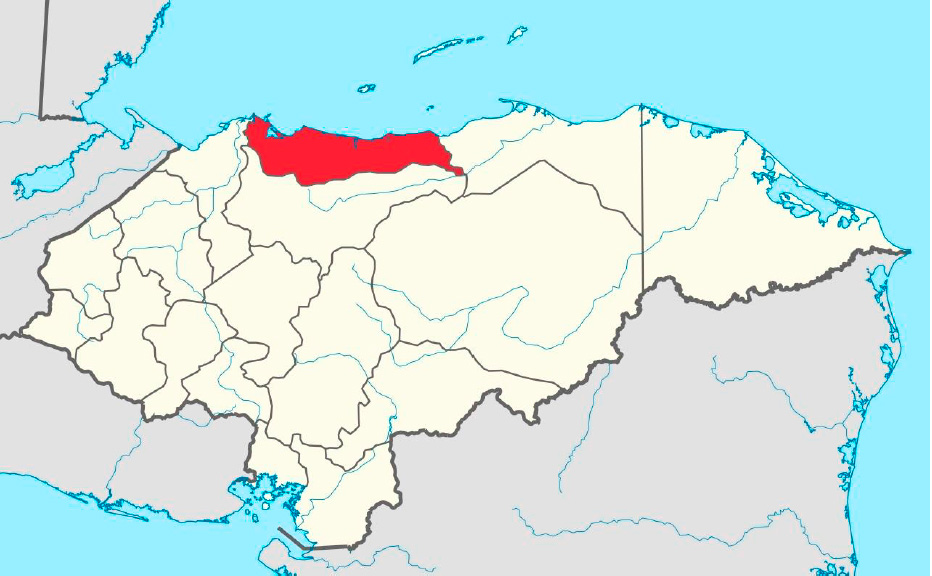
Figure 1. Honduras map, in red, shows the main Garifuna area, mainly the Atlantida department. The map was created by the authors with metadata from Google Earth.
Therefore, evaluating the predetermined variables established by the International Telecommunication Union (ITU) as sectoral indicators is imperative to obtain information on the use and potential opportunities associated with communication technologies11. This assessment is crucial due to the lack of knowledge of the indicators of access to telecommunications in the region, which makes it necessary to have accurate data to understand the Garifuna community's technological behavior effectively.
One of the objectives of this paper is to describe the behavior of indicators of access to telecommunications services in the Garifuna community in northern Honduras. This includes variables such as monthly budget for telecommunications services and hours of use of computers and mobiles. Likewise, it is intended to analyze the behavior and digital knowledge of the Garifuna community concerning sexually transmitted diseases (STDs). This will be done through the crossover of technology with common knowledge among the Garifuna.
The results of this research will provide a better understanding of the Garifuna community's access to telecommunications services and their digital behavior and knowledge. This information can be used to develop policies and programs that promote digital inclusion in this community. The article is divided into a theoretical base focused on the background of the Garifuna community and their access to telecommunications, digital behavior, and knowledge.
MATERIALS AND METHODS
Theoretical foundation
The Garifuna community of Honduras is an Afro-descendant ethnic group that inhabits the Caribbean coast of Honduras, Guatemala, Belize, and Nicaragua. There are about 300,000 Garifuna in Honduras, 2% of the country's total population3. Historically, Honduran society has relegated and discriminated against the Garifuna community. This has negatively impacted the community's development, including access to primary education, health, and telecommunications9.
Access to telecommunications is a fundamental right that enables people to communicate, access information, and participate in society. In recent years, there has been a significant increase in access to telecommunications in Honduras6. However, this increase has not been uniform, and the most vulnerable communities, such as the Garifuna community, continue to have limited access to these services, according to available regulatory data3.
Digital behavior and knowledge are essential aspects of telecommunications access. Digital behavior refers to how people use digital technologies, while digital knowledge refers to understanding basic concepts related to these technologies. In the Garifuna community, it has been observed that there is broad access to telecommunications services but low knowledge of the basic concepts associated with these technologies 6. This may limit the community's effective use of telecommunications.
METHODS
The instrument used was a semi-structured questionnaire with open and closed questions to collect data and thus respond to the questions and objectives of the research12. The sample was based on intentional quotas through the snowball method13 to reach the study participants. The sample comprised 25 people, including seven men and eighteen women. Obtaining participants to contribute to collecting relevant data for this study has been complex due to fears of discrimination. Data was collected electronically between January and May 2022; any Honduran participant could complete the instrument. All data obtained from the Garifuna ethnic group corresponded to residents of the department of Atlántida, Honduras3.
This study used positivist methodology based on structured data collection and quantitative methods, identifying the variables, their magnitudes, and the relationships between them. The variables studied were adapted from indicators found in historical publications of regulatory entities and statistical studies in Honduras and those we consider appropriate. A descriptive statistic of the age of the interviewees was carried out, using measures of central tendency. Relative values were used to describe the other variables, focusing on the statistical mode of the responses.
The knowledge of converging technologies and their usefulness represents a tiny explored aspect, surrounded by local idiosyncrasies, often influenced by linguistic aspects specific to the region. Data of this type were collected through open-ended responses and analyzed using a text analysis algorithm14. A topical, prioritized, and relevant topic for this community was used, explicitly asking if they knew what a mobile application was and if they would use one that would help expand their knowledge about sexually transmitted diseases, especially HIV, which is an essential topic for the Afro-descendant community. The responses were analyzed using graph diagrams to understand the interconnection of the terms and their weights15.
Analyzing and evaluating unstructured texts containing qualitative data is quantitatively evaluating unstructured texts containing qualitative information. It uses patterns, which group words and roots. This method searches within the object's text for each word or root, generating a unit value for each hit that is successively added to each pattern. You can create as many patterns as words or roots are required, but each pattern will be assigned a weight; the higher it is, the more critical it will be in the analysis. The hits are subjected to combined arithmetic operations already defined in this application, which return an absolute value equal to or greater than zero and less than or equal to unity, with values close to zero indicating a lower incidence of patterns14.
Graph diagrams are used in various fields, including computer science, mathematics, network theory, artificial intelligence, and game theory. They are a powerful tool for representing relationships and connections between elements. In a graph diagram, nodes can represent entities such as people, objects, locations, or concepts, and arcs can represent relationships, connections, dependencies, or interactions between these entities. Graphs can be directed (with directed arcs) or undirected (without direction in the arcs) and can have additional features, such as weights in the arcs, to represent the force or distance between the connections16-18.
The data used in this research were obtained from the project "HIV prevention through new information and communication technologies (ICTs) in Honduras," which were collected using a semi-structured questionnaire-type instrument12. The project aimed to improve access for key populations to complementary end-of-life services, providing a pleasant user experience that promotes HIV/AIDS prevention and diagnosis using convergent and ubiquitous technologies. At the time of this study, the level of knowledge, attitudes, myths, and beliefs about the use of mobile applications and information and communication technologies for HIV prevention is unknown. In addition, data is lacking to analyze costs, economic viability, and resources needed to develop multiplatform applications for HIV prevention and diagnosis in critical populations.
The research approach was non-experimental and cross-sectional, as the variables were not manipulated, and a single measurement was made at a given time. However, the study has a descriptive scope because it revealed the behavior of using applications, information, and communication technologies. A mixed approach was used, as both quantitative and qualitative elements were obtained through the questionnaire. Since the primary sources come directly from the target population, the data collected are primary19.
RESULTS
Participants range in age from 18 to 78 years old. The results revealed a mean age of approximately 30 years and a median of 27 years, with a modality between 24 and 35 years. The standard deviation is 12.57 years, and the range is 60 years. The age distribution is not normal and shows moderate dispersion. Regarding the highest level of education attained, 20 percent have completed primary education, 28 percent have incomplete secondary education, 32 percent have completed secondary education, 12 percent have an incomplete university education, and 8 percent have completed university education.
All participants reported having a primary occupation, distributed among students (32%), workers (32%), professionals (28%) and merchants (8%). Monthly income in U.S. dollars (USD) is distributed as follows: income less than or equal to one hundred dollars per month (84%), income more significant than one hundred dollars, and less than or equal to three hundred dollars (8%), and income above the ranges mentioned here (8%).
ICT access indicators
Regarding the variables related to access to technological and computer resources, 72% of the participants have their personal computer, of which 44% own a laptop and 28% a desktop computer. None of them mentioned having more than one computer. Participants primarily use their computers for activities at home, and only 12% for work activities at a time. All participants reported having a smartphone. Of those, 88% use the Android operating system, and 12% use iOS.
The primary reported use of the mobile phone is for calls (40%), followed by messaging or chat (24%), internet browsing (16%), social media access (12%) and gaming (8%). When asked about the most used app, WhatsApp is the dominant one (88%), followed by Facebook (6%) and TikTok (6%). Only 12% of participants own a tablet; all use Android. They reported using it exclusively for leisure and entertainment activities at home. The most viewed content includes entertainment videos (80%), followed by written news (12%) and education (8%). Regarding the number of hours dedicated to using technological devices, the mobile phone is the most used, with more than four hours a day, while the computer has less than an hour daily. Figure 2 shows the graphical behavior of the hours of use.
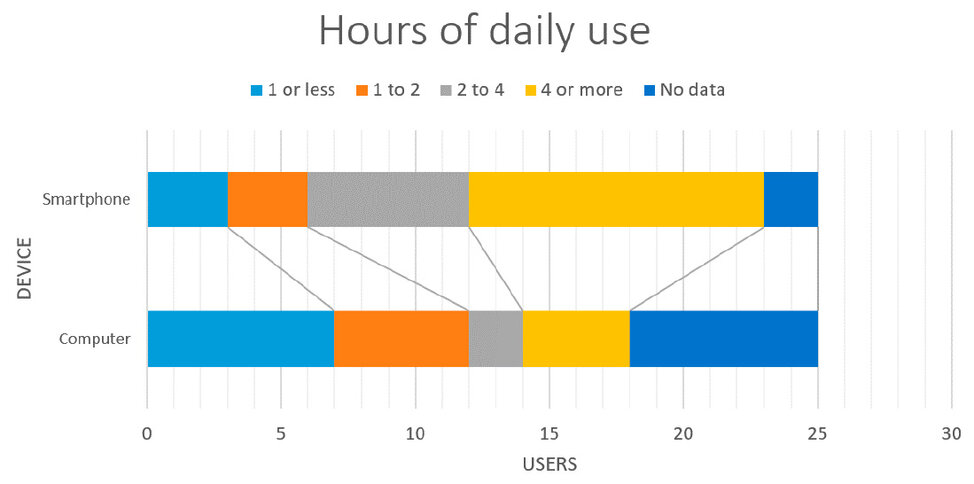
Figure 2. Comparison of the hours of daily use of the computer and the smartphone.
As for the type of mobile service contracted, 96% have it in prepaid mode. The monthly budget for this service varies greatly, with 20% spending $2 or less, 48% spending more than $2 but less than or equal to $12, and 32% spending more than $12 per month. Regarding the quality of the service, 60% perceive it as good, 24% perceive it as very good, and 16% perceive it as wrong.
As for residential fixed internet service, 60% say they have it contracted in their homes for personal or family use. The rest have stated that they do not have it for economic reasons, although there is coverage from at least one provider in their residence. No questions were asked about costs or perceived quality of service received.
ICT graphic schema
The responses varied for this section; many were not easily understood due to their wording. On average, each answer consisted of fifteen words written in prose. They all shared the common thread of containing at least one verb, adjective, or adverb in some form. Using the algorithm for unstructured text analysis, the answers to each question were narrowed down to standard terms. These terms were then associated with each other when they appeared simultaneously, and their frequency became the weights of the vertices, with the mentioned terms becoming the nodes, these values representing the input data to construct the graphs20.
Graph diagrams have allowed for the analysis and clear visualization of the relationships between the terms of the responses, modeling how they are interconnected. The graphs and vertices obtained denote a highly heterogeneous behavior. Cross-matrices have been intentionally omitted to simplify the presentation of the results.
The answer to the question, "Can you define what a computer application is?" received the shortest set of answers of all. No technically adequate response was found. The general conclusion is that they do not know or believe an app is Google. According to the analysis, it behaves as shown in the graph in Figure 3.
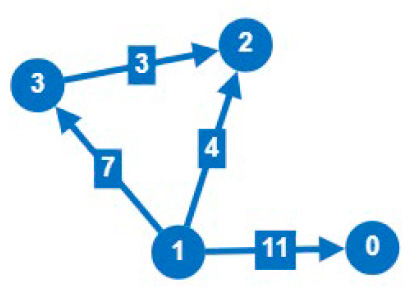
Figure 3. Chart with Nodes and Weights, Unknown (0), Google (1), Program (2), Tool (3)
The answer to the question, "Do you think an app can help prevent STIs?" received answers within an average of ten words. They drew attention to direct transitive verbs (socialize, educate, update, and consult). In the case of "consult," it is a verb that can also be intransitive. Direct transitive verbs require a direct object to complete the meaning of the action they express. The direct object is the direct recipient of the verb's action, i.e., what the verbal action directly affects. The intransitive verb is the one that does not require more information to complete its action; that is, it cannot have an associated or a direct object. This behavior is shown in Figure 4.
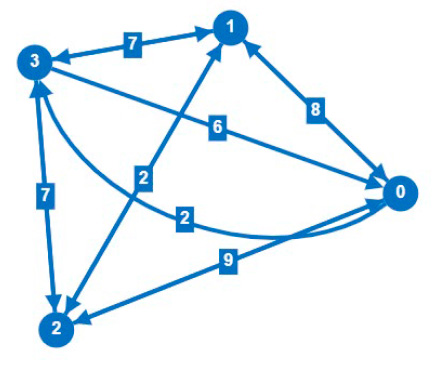
Figure 4. Graph with nodes and weights, socialize (0), teach (1), update (2), query (3)
Finally, respondents who answered, "Do you think apps can diagnose STDs?" received the most extensive responses, averaging fifteen words each. The answers mainly were yes or no, but the negatives were justified in impossibility, prevention, awareness, and before. It should be noted that the typical configuration of the answer is negative, with terminology that is impossible but can raise awareness. The resulting graph can be seen in Figure 5.
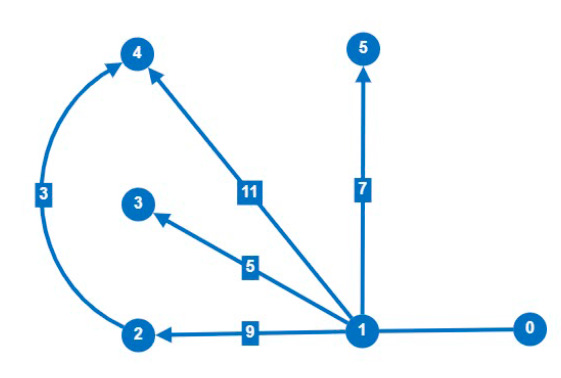
Figure 5. Graph with nodes and weights, yes (0), no (1), impossible (2), prevent (3), awareness (4), before (5)
DISCUSSION
Notably, the participants are of extreme ages; several correspond to a generation that does not adopt information technologies in their lifestyles. For future studies, an exclusion criterion should be established by year of birth to avoid introducing biases, following proposed schemes such as those of Cappa21. Regarding educational level, 48% of them are in the range of average years of schooling reported for the State of Honduras3; 52% are above this value, so they have access to more education than the general population. It denotes a community focused on work and study; there is no mention of people without income. This contrasts with the fact that 84% of respondents survive on less than USD3.33 a day, lower than the country's average of USD5.833. This indicates the economic backwardness in this community22.
Despite having incomes below the national average, approximately three out of four respondents own a personal computer, which is triple the national average of only one in five Hondurans. All of them own a smartphone; this is the same as the indicators, where it is reported that all Hondurans own one or more of these devices7.
The most used device is the smartphone, which allows them to carry out more computing activities, even considering that three out of four respondents own a personal computer at home. The ubiquitous ownership of mobile technologies is the aspect to be highlighted since, if we compare it with the economic occupations carried out by the respondents, the smartphone becomes the ideal and helpful device for these daily activities. According to data reported by the regulatory body3 in global terms of the country, where an average Honduran uses technological devices on average once a day, which contrasts with the fact that the Garifuna surveyed uses more than four hours a day the smartphone and one hour the personal computer, they are well above the national average, with high technological adoption.
Access to internet service is preferably via smartphone, where the cost is around USD12 per month, as reported by 68% of respondents. This amount is higher than the global average of USD 9.60 per month5. This cost will likely be used to contract specific service packages on the Internet since the most significant use is to use the chat service and access social networks. 60% of respondents have access to residential Internet, double the national average of 32%3.
The Garifuna surveyed have high rates of literacy and technological adoption. Despite this, they have an economic backwardness that this study cannot explain, which contrasts with the behavior of adopting new technologies in an accelerated way. This inequality needs to be explained by other variables, so a better ranking in terms of the age ranges of participants in subsequent studies should be considered.
CONCLUSIONS
There is a disparity between the average monthly income reported by the Garifuna surveyed and the average monthly expenditure on telecommunications services. 85% of people with incomes less than or equal to USD 100 use between 2% and 12% of their income to purchase mobile services. This is equivalent to the income of four days of work. Likely, the phenomenon of remittances and the economic support of family members who emigrated abroad is a hidden variable in these data. The most used application is WhatsApp since there are cheap top-ups in the country that activate the services of this application for several days, allowing it to be used for messaging, calls, and entertainment. In the local idiosyncrasy, it is known that WhatsApp is used as a social network by groups of people with similar interests and has become a source of entertainment. That's why we see more than four hours a day of mobile devices versus an hour or less of computer use. The high access rate to the residential fixed internet service is because it is complemented by subscription television, where we observe that the leisure factor of these services is prioritized.
This study indicates that increasing access to telecommunications and technological devices is not enough since it requires appropriating the paradigms and concepts that have given rise to all this technological progress. This is a new frontier in the field of the digital divide that must be reviewed in the coming years so that technologies are a crucial factor of change and positively impact respondents' quality of life. We can extrapolate this conclusion to other areas of knowledge, as only 8% of respondents use educational, technological means, although students represent 32% of the sample; this is why we conclude that the Garifuna suffers from digital orphanhood. The data highlight the need to establish exclusion criteria by birth year in future studies to avoid bias. In addition, it is recommended that the factors that drive the adoption of information technologies by the Garifuna community be investigated to understand the role of ICTs in combination with the economic lag found. With this, opportunities can be detected to relate to this ethnic group more assertively, with different needs beyond those associated with HIV. In this way, timely attention can be given to the Garifuna, and the guidelines must be taken according to the needs that must be solved.
Author Contributions: Conceptualization and methodology by C. Agudelo-Santos software, validation, formal analysis, J.I. Zablah.; investigation, resources, data curation, writing—original draft preparation, writing—review and editing, C. Agudelo-Santos; visualization, supervision, J.I. Zablah; project administration, funding acquisition, C. Agudelo-Santos. All authors have read and agreed to the published version of the manuscript.
Funding: through Global Communities within their projects, FONDO GLOBAL funded the original dataset collection.
Institutional Review Board Statement: Not applicable.
Informed Consent Statement: Not applicable.
Data Availability Statement: Not applicable.
Acknowledgments: We would like to thank Global Communities, especially Mario Cooper, MD., for their support in obtaining the data used in the publication of this manuscript. We thank Dr. Salvador Diaz Cano for his unconditional support in interpreting the data and understanding the topic.
Conflicts of Interest: The authors declare no conflict of interest.
REFERENCES
1. Galperin, H.; Mariscal, J. (Eds.). Digital poverty: Latin American and Caribbean perspectives. Practical Action Publishing, Rugby, England, 2007.
2. Codding, G.A. Jr. Evolution of the ITU. Telecomm Policy 1991;15(4):271–85. DOI: 10.1016/0308-5961(91)90050-l
3. INE. Encuesta permanente de hogares de propósitos múltiples. Instituto Nacional de Estadistica (Honduras) 2024 URL https://ine.gob.hn/V3/ephpm/ (Accessed on march 9, 2024)
4. ITU. The world's richest source of ICT statistics and regulatory information – 2022. URL https://datahub.itu.int/ (Accessed on march 9, 2024)
5. ITU: Committed to connecting the world. URL https://www.itu.int (Accessed on march 9, 2024)
6. CONATEL. Informe Anual 2021 Comision Nacional de Telcomunicaciones - 2021 URL https://www.conatel.gob.hn/doc/Informes/2022/Informe%20Anual%20del%20Sector%20de%20Telecomunicaciones%202021.pdf (Accessed on march 9, 2024)
7. CONATEL – Comision Nacional de Telecomunicaciones. URL http://www.conatel.gob.hn (Accessed on march 9, 2024)
8. HONDUTEL. Empresa Hondurena de Telecomunicaciones. URL http://www.hondutel.hn (Accessed on march 9, 2024)
9. Thorne, E. Land rights and garífuna identity. NACLA Rep Am 2004;38(2):21–5. DOI: 10.1080/10714839.2004.11724510
10. Johnson, J.L; Callahan, C. Minority cultures and social media: Magnifying Garifuna. J Intercult Commun Res. 2013;42(4):319–39. DOI: 10.1080/17475759.2013.842608
11. Sang, Z., Li, K. ITU‐T standardization activities on smart sustainable cities. IET Smart Cities 2019;1(1):3–9. DOI: 10.1049/iet-smc.2019.0023
12. Diaz, S.; Cooper, M.; Molina, Y.; Zablah, I.; García Loureiro, A.; Agudelo-Santos, C.; Madrid, M.; Madrid Me.; Rodriguez, J.; Urmeneta, J.; Valle, J. Information and communication technologies (ICT) access indicators in the LGBTQ+ population with a high risk of contagion by acquired immunodeficiency virus (HIV) in Honduras. Bionatura 2023;8(2):1–9. DOI: 10.21931/rb/2023.08.02.34
13. Snijders, TAB. Estimation on the basis of snowball samples: How to weight?. Bull Methodol Sociol 1992;36(1):59–70. DOI: 10.1177/075910639203600104
14. Zablah, J.I.; Corrales, I.X.; Aguilar, J.M.; Garcia, A.; Gomez, F.; Medina, M.T. Performance limitations of a text search application running in cloud instances. IEEE Lat Am Trans 2016;14(3):1499–506. DOI: 10.1109/tla.2016.7459641
15. Diestel, R.; Schrijver, A. Seymour P. Graph theory. Oberwolfach Rep 2010;521–80. DOI: 10.4171/owr/2010/11
16. Thomassen, C. Reflections on graph theory. J Graph Theory 1986;10(3):309–24. DOI: 10.1002/jgt.3190100308
17. Acevedo-Duque, A.; Vega-Muñoz, A.; Salazar-Sepúlveda, G. Analysis of hospitality, leisure, and tourism studies in Chile. Sustainability. 2020;12(18):7238. DOI: 10.3390/su12187238
18. Acevedo-Duque, A.; Llanos-Herrera, G.R.; García-Salirrosas, E.E.; Simón-Isidoro, S. Álvarez-Herranz, A.P.; Alvarez-Becerra, R.; Scientometric analysis of hiking tourism and its relevance for wellbeing and knowledge management. Int J Environ Res Public Health 2022;19(14):8534. DOI: 10.3390/ijerph19148534
19. Thompson, C.B.; Panacek, E.A. Research study designs: Non-experimental. Air Med J 2007;26(1):18–22. DOI: 10.1016/j.amj.2006.10.003
20. Ali, S.; Yan, Q.; Irfan, M.; Ameer, W.; Atchike, D.W.; Acevedo-Duque, A. Green investment for sustainable business development: The influence of policy instruments on solar technology adoption. Front Energy Res 2022;10. DOI: 10.3389/fenrg.2022.874824
21. Robinson, O.C. Sampling in interview-based qualitative research: A theoretical and practical guide. Qual Res Psychol 2014;11(1):25–41. DOI: 10.1080/14780887.2013.801543
22. Banco Central de Honduras. Memoria 2019. URL https://www.bch.hn/estadisticos/GIE/LIBMemoria/Memoria%20Anual%202019.pdf (Accessed on march 9, 2024)
Received: January 10 20243/ Accepted: February 12 2024 / Published:15 March 2024
Citation: Agudelo-Santos C, Zablah I. Measuring the digital behavior for health purposes of the Garifuna community in Atlántida, Honduras. Bionatura Journal 2024; 1 (1) 27. http://dx.doi.org/10.21931/BJ/2024.01.01.27
Additional information Correspondence should be addressed to [email protected]
Peer review information. Bionatura Journal thanks anonymous reviewer(s) for their contribution to the peer review of this work using https://reviewerlocator.webofscience.com/
All articles published by Bionatura Journal are made freely and permanently accessible online immediately upon publication, without subscription charges or registration barriers.
Publisher's Note: Bionatura Journal stays neutral concerning jurisdictional claims in published maps and institutional affiliations.
Copyright: © 2024 by the authors. They were submitted for possible open-access publication under the terms and conditions of the Creative Commons Attribution (CC BY) license (https://creativecommons.org/licenses/by/4.0/).
